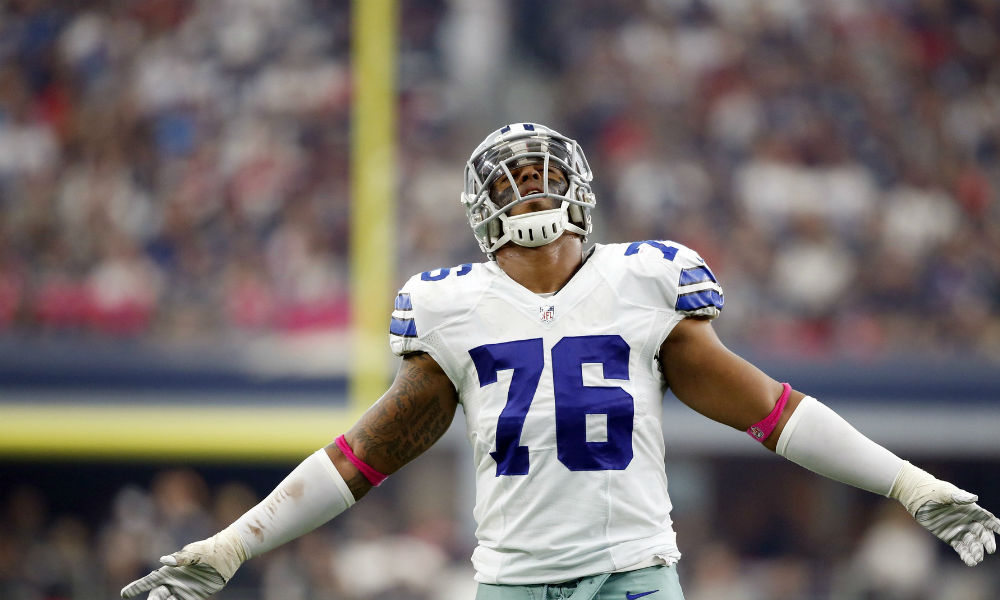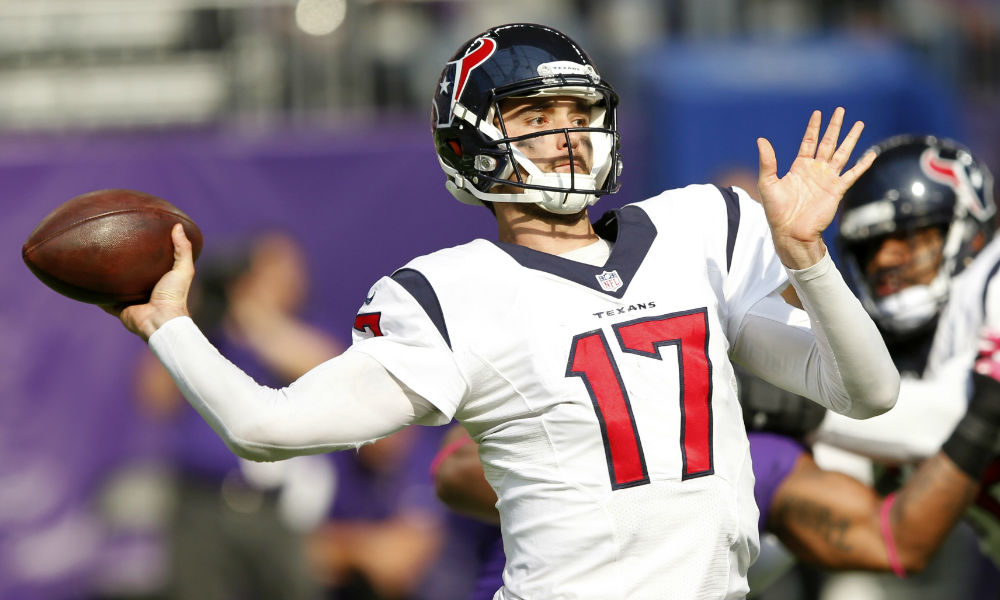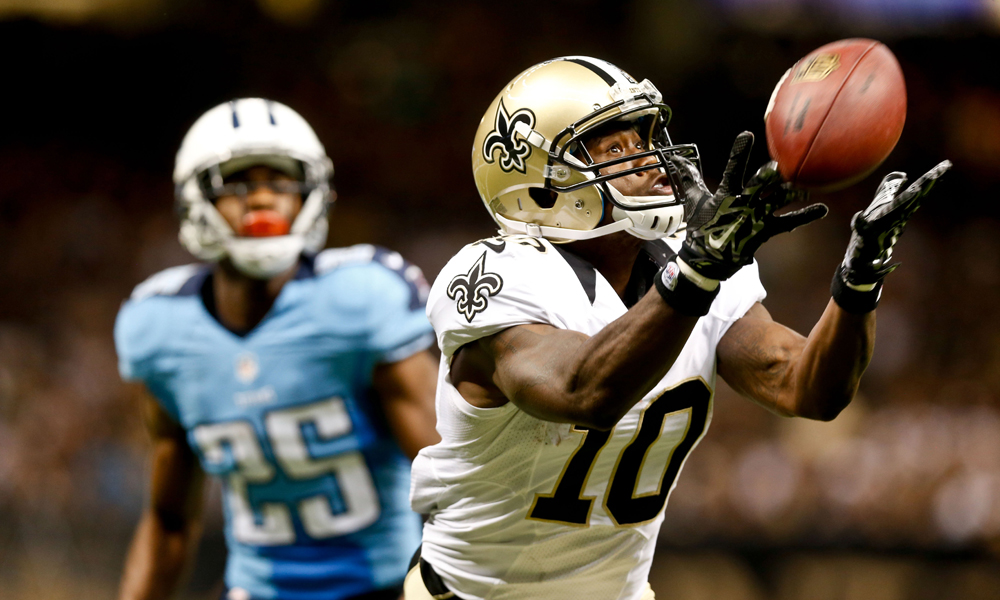News
How Jim Schwartz Unlocked The Best in Brandon Graham For A Second Time
Once thought to be a draft bust, Philadelphia’s Brandon Graham is thriving under Jim Schwartz, for a second time.
Things haven’t gone the way the Philadelphia Eagles hoped over the past few weeks, divisional losses on the road at Dallas and the New York Giants pushing them from near the top of a competitive NFC East to the bottom. But even through their most recent struggles, the Eagles are getting a strong return on a long-term investment that was once thought to be a complete bust.
That investment is defensive end Brandon Graham, who the Eagles traded up to draft in the first round in 2010, then signed to a four-year contract extension in the 2015 offseason. That contract is now looking like a bargain because, after six seasons of potential with little production, Graham has established himself as one league’s best defensive ends through the first half of the 2016 season.
That success comes in large part thanks to the addition of Jim Schwartz as Eagles defensive coordinator. Schwartz has been credited by his charges with remaking the Philadelphia defense on the fly, with no one benefitting more than Graham, who not too long ago was labeled a draft bust in Philly. Now he ranks as one of the best edge defenders in the league according to Pro Football Focus.
“He’s a perfectionist. He doesn’t like going into a game without knowing that we know it,” Graham said of Schwartz. “He wants us to demand a lot from ourselves and each other, and I think you see it’s been showing up in the games.”
But more importantly, Schwartz is deft at correctly utilizing the personnel he has and making the scheme fit the player, not vice versa, as so many coordinators across the league try to. Graham has benefitted from that expertise as well, as Schwartz has allowed him to focus on getting into the backfield, where he feels most comfortable.
“It is definitely very nice and a great feeling for me because now I can go out there and play the run and go get the quarterback and not worry about nothing else,” he said. “I think in this defense, you don’t have too many rules. Disrupt everything and make plays in the backfield. It’s all about the knock back.”
AN INAUSPISCOUS START
The knock back on Graham was significant in the early stages of his career.
Philadelphia had high hopes when they drafted him with the 13th overall pick in the 2010 NFL Draft out of Michigan. After making the transition from linebacker to the defensive line as a sophomore, Graham emerged as an elite talent causing havoc in opposing backfields to the tune of 28.5 sacks and 56 tackles for loss in his final three seasons at Michigan.
Graham was even more highly touted in the pre-draft process as one of the more polished pass rush prospects. Who helped get him to that point? None other than Jim Schwartz, who coached Graham in the Senior Bowl. The Michigan defensive end logged two sacks and forced a fumble to earn MVP honors for the game, and his draft stock syrocketed as a direct result.
In fact, Philadelphia traded two third-round picks to the Denver Broncos to move up 11 spots and take Graham. He was the first defensive end off the board and the fourth defensive lineman taken in the draft at large behind Ndamukong Suh (Detroit), Gerald McCoy (Tampa Bay) and Tyson Alualu (Jacksonville).
At the time, the Eagles were coming off a second straight playoff berth and had the makings of a dynamic offense led by running back LeSean McCoy and wide receiver DeSean Jackson. But Philadelphia had some holes on defense, exposed in back-to-back losses to the Cowboys to end the season. They aimed to pair Graham with Trent Cole, who, at 27 years old, was coming off his best season and a Pro Bowl selection, to create an elite pass rush pairing they believed could drive their defense forward.
But that never really materialized. Graham was used sparingly as a rookie under defensive coordinator Sean McDermott, playing 13 games with just six starts. Then, toward the end of that season, Graham went down with a torn ACL. Aside from Cole, the Eagles struggled to get after the quarterback as a group and Graham still ranked near the top of the team in sacks despite accumulating just three.
The ACL injury forced Graham to miss most of the 2011 season as well, as he played in two games in November, then one more in December before being shut down for the season. Graham was fully healthy in time for the 2012 season but his playing time, and as a result, his impact was still limited early on in that campaign. However, there is a clue from that 2012 season that could’ve hinted at Graham’s breakout this season.
However, there is a clue from that 2012 season that could’ve hinted at Graham’s breakout this season.
BETTER UNDER BOWLES
In the middle of the 2012 season, the Eagles made a change at defensive coordinator, firing Juan Castillo and replacing him with now Jets head coach Todd Bowles on an interim basis.
Graham didn’t make an immediate impact under Bowles either, but as opportunity came his way late in the season, he began to thrive. Once he got familiar with his personnel, Bowles put Graham in a role similar to the one he’s been playing under Schwartz this season, and it paid dividends then just like it has in 2016.
In the month of December 2012, Graham logged four of his then career-high 5.5 sacks and 25 of his 38 tackles. In a game against Dallas, he got to Cowboys quarterback Tony Romo twice in a game the Eagles nearly pulled out before a late turnover by the offense killed their chances. Two weeks later, he led a Thursday night Philadelphia sack parade against the Bengals logging 2.5 of the Eagles’ six on Andy Dalton. Graham had seemingly finally tapped into that potential that made him a Top 15 pick and was ready to make an impact with the Eagles during his fourth season in 2013.
But then sweeping changes came to Philadelphia. When Andy Reid left town, Bowles moved to Arizona, where he had great success implementing a similar system that eventually got him the Jets head job. Meanwhile, the Eagles hired Chip Kelly, who brought in a brand new staff that greatly hindered Graham’s ability to succeed early on in their tenure.
OUT OF POSITION
Under Kelly, the entire Eagles franchise underwent some radical changes, and while Kelly was more geared toward changing the offense, the defense wasn’t exempt. Perhaps no player felt that and was affected more than Graham in that first season.
“[The 2012 season] was my first time starting after my injury and I ended up getting five-and-half sacks,” Graham said. “I really felt like I was headed in the right direction. And then, bam, here comes the 3-4.”
Kelly brought in Bill Davis to be his defensive coordinator and Davis implemented a 3-4 defense. Since Graham didn’t have the size to play 3-4 end, he moved to outside linebacker, where he began his college career without much success before transitioning to end. The results were similar.
Graham struggled to adapt, and his transition was made more difficult by Philadelphia’s pace of play, which drove players to the point of exhaustion. That pace was one thing for players in positions they were accustomed to, but for someone like Graham, trying to learn new schemes and techniques from a different spot on the field, it was hell.
The Eagles had success during Kelly’s first year, winning the NFC East for the first time since Graham’s rookie year. But it was a lost season for the fourth year pro out of Michigan. He didn’t start a single game, relegated to a rotational role and time on special teams, and logged just three sacks all year.
As Graham scuffled, his struggles were magnified by the success of the other player the Eagles considered taking at No. 13 overall in 2010 but passed on in favor of Graham, Texas safety Earl Thomas. By the end of the 2013 season, Thomas had emerged as the league’s premier free safety for the Seattle Seahawks, a generational talent that was changing the game at the position while leading the league’s best defense to a Super Bowl XLVIII destruction of the Denver Broncos.
Fans and pundits pointed to the selection of Graham over Thomas by the Eagles, who spent the next several years in dire need of help at safety while defensive ends and linebackers passed Graham on the depth chart, as one of the worst draft day decisions in recent memory. The Philadelphia portion of that criticism fell on Graham who went as far as to call himself a bust, though he tried to use it as motivation.
“Right now, I’m a bust, so I’m going to deal with that,” Graham told Jonathan Tamari of the Philadelphia Inquirer. “I’m a bust, and I’m going to keep being a bust. Even when I make plays, I’m going to still act like I’m a bust. You know what I’m saying?”
UNLOCKING EXCELLENCE
Despite his struggles in the first year under Kelly, Graham charged on and in the final two years of the Kelly/Davis regime, he emerged as something of an impact player at linebacker.
He got just one start in the fifth and final season of his rookie contract, but embraced a rotational role and matched his career-high with 5.5 sacks. That offseason, he made the surprising decision to stay in Philadelphia, signing a four-year, $26 million deal. He followed that up with the best year of his young career, earning a bigger role, with 10 starts in 16 games, and taking advantage to set a new career-high with 6.5 sacks. The Eagles weren’t quite getting first round production out of Graham, but he’d at the very least become an important piece of the defense.
But when the Kelly regime moved out of town, replaced by Doug Pederson — a former staffer of Andy Reid, who drafted Graham — his new staff saw much more in Graham than the previous crew had. No one moreso than defensive coordinator Jim Schwartz, who recalled the talent he’d seen in Graham all those years prior at the Senior Bowl and knew the now 28-year-old had all the attributes to be an elite defensive end in the NFL.
“[Graham] was my MVP,” Schwartz joked after being tabbed in Philly. “I helped him get drafted in the first round. He might owe me a little bit of that signing bonus.”
Once installed as the Philadelphia defensive coordinator, Schwartz brought back the wide-nine defense that had become synonymous with the Eagles during the team’s success under Reid, but he simplified the scheme added some wrinkles that benefitted Graham specifically. The new defensive coordinator made Graham one of the centerpieces of his pass rush for the first time in his career and the seventh year pro quickly fell in love with his role, especially since it didn’t put him in coverage anymore.
“The scheme—I felt right at home as soon as it happened—I just had to learn the terminology and stuff like that, but it’s comfortable. Now I don’t have to worry about dropping too much, I can just go get the QB, stop the run, and stay in the backfield,” Graham told Pro Football Focus in August. “I prefer the 4-3 because it’s just straight ahead—go get ’em.”
That’s exactly what Graham has done. He logged sacks in each of Philadelphia’s first three games and has four for the season, on pace for a career-high eight, though his sights are set considerably higher than that. And Graham’s best game of his career might have come in a contest when he didn’t log a sack at all. Two weeks ago in Philadelphia’s heartbreaking loss to the Dallas Cowboys, Graham was a monster despite having the league’s best offensive line blocking his path. The pass rusher logged 11 pressures, eight hurries and three hits on Cowboys quarterback Dak Prescott. Additionally, he had four stops against the run and six tackles overall. Despite the loss, PFF selected him as their Player of the Week.
Through eight games, Graham remains on track for his best season as a pro, the fact that it’s coming in his seventh year in the league is a rarity, especially because all of those seasons have come as a member of the same team. Usually after watching a first round pick fall so far short of the expected production, teams will cut bait, whether the lack of production is caused by the player or the scheme. Sometimes that player will go on to thrive elsewhere, and it’s now apparent that likely would have happened with Graham. But the Eagles held onto him and they have to be glad they did, as they are now reaping the benefits of an elite talent, at a bargain price, that could be a building block on defense for years to come.
News
Buccaneers admit mistake, boot Aguayo
Source: Mike Florio of ProFootballTalk
Powered by WPeMatico
News
Did Bucs put too much pressure on Aguayo?
Source: Mike Florio of ProFootballTalk
Powered by WPeMatico
News
Broncos holding their breath on Derek Wolfe
Source: Mike Florio of ProFootballTalk
Powered by WPeMatico




